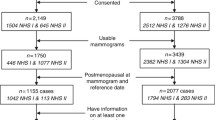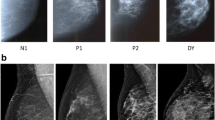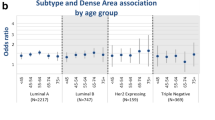Abstract
Objective
To examine the association between breast density and risk of breast ductal carcinoma in situ (DCIS).
Methods
We assessed breast density in relation to DCIS risk using combined data from statewide mammography registries in NH and VT. The prospective analyses were based on 572 DCIS cases arising in 154,936 women (58,496 premenopausal and 96,440 postmenopausal). Women in the study were followed on average 4.1 years. Breast density was scored by community radiologists using BIRADS categories (fatty, scattered density, heterogeneous density, extreme density).
Results
In premenopausal women, based on 157 cases, the RR for DCIS risk were 0.29 (95% CI: 0.0.04, 2.24) for fatty breasts, 2.06 (95% CI: 1.39, 3.05) for heterogeneous density, and 2.40 (95% CI: 1.47, 3.91) for extreme density, relative to scattered density. In postmenopausal women, based on 369 cases, the RR for DCIS risk were 0.58 (95% CI: 0.37, 0.93) for fatty breasts, 1.41 (95% CI: 1.12, 1.78) for heterogeneous density, and 1.49 (95% CI: 0.93, 2.37) for extreme density, relative to scattered density. The possible interaction between breast density and menopausal status in relation to DCIS risk was not statistically significant.
Conclusions
We observed an association between breast density and DCIS risk. Although the association seemed stronger in premenopausal women, there was no evidence of an interaction involving breast density and menopausal status.
Similar content being viewed by others
References
Ernster VL, Ballard-Barbash R, Barlow WE et al (2002) Detection of ductal carcinoma in situ in women undergoing screening mammography. J Natl Cancer Inst 94:1546–1554
Habel LA, Dignan JJ, Land SR, Salane M, Capra AM, Julian TB (2004) Mammographic density and breast cancer after ductal carcinoma in situ. J Natl Cancer Inst 96:1467–1472
Boyages J, Delaney G, Taylor R (1999) Predictors of local recurrence after treatment of ductal carcinoma in situ: a meta-analysis. Cancer 85:616–628
Warnberg F, Yuen J, Holmberg L (2000) Risk of subsequent invasive breast cancer after breast carcinoma in situ. Lancet 355:724–725
Leonard GD, Swain SM (2004) Ductal carcinoma in situ, complexities and challenges. J Natl Cancer Inst 96:906–920
Baxter NN, Virnig BA, Durham SB, Tuttle TM (2004) Trends in the treatment of ductal carcinoma in situ of the breast. J Natl Cancer Inst 96:443–448
Sewell CW (2004) Pathology of high-risk breast lesions and ductal carcinoma in situ. Radiol Clin North Am 42:821–30, v
Provenzano E, Hopper JL, Giles GG, Marr G, Venter DJ, Armes JE (2004) Histological markers that predict clinical recurrence in ductal carcinoma in situ of the breast: an Australian population-based study. Pathology 36:221–229
Renshaw AA, Derhagopian RP, Tizol-Blanco DM, Gould W (2004) Papillomas and atypical papillomas in breast core needle biopsy specimens: risk of carcinoma in subsequent excision. Am J Clin Pathol 122:217–221
Page DL (2004) Breast lesions, pathology and cancer risk. Breast J 10(Suppl 1):S3–S4
Ali-Fehmi R, Carolin K, Wallis T, Visscher DW (2003) Clinicopathologic analysis of breast lesions associated with multiple papillomas. Hum Pathol 34:234–239
Rodrigues NA, Dillon D, Carter D, Parisot N, Haffty BG (2003) Differences in the pathologic and molecular features of intraductal breast carcinoma between younger and older women. Cancer 97:1393–1403
Wohlfahrt J, Rank F, Kroman N, Melbye M (2004) A comparison of reproductive risk factors for CIS lesions and invasive breast cancer. Int J Cancer 108:750–753
Claus EB, Stowe M, Carter D (2003) Oral contraceptives and the risk of ductal breast carcinoma in situ. Breast Cancer Res Treat 81:129–136
Claus EB, Stowe M, Carter D (2001) Breast carcinoma in situ: risk factors and screening patterns. J Natl Cancer Inst 93:1811–1817
Patel AV, Press MF, Meeske K, Calle EE, Bernstein L (2003) Lifetime recreational exercise activity and risk of breast carcinoma in situ. Cancer 98:2161–2169
Kerlikowske K, Barclay J, Grady D, Sickles EA, Ernster V (1997) Comparison of risk factors for ductal carcinoma in situ and invasive breast cancer. J Natl Cancer Inst 89:76–82
Trentham-Dietz A, Newcomb PA, Storer BE (2000) Risk factors for carcinoma in situ of the breast. Cancer Epidemiol Biomarkers Prev 9:697–703
Lambe M, Hsieh CC, Tsaih SW, Ekbom A, Trichopoulos D, Adami HO (1998) Parity, age at first birth and the risk of carcinoma in situ of the breast. Int J Cancer 77:330–332
Weiss HA, Brinton LA, Brogan D et al (1996) Epidemiology of in situ and invasive breast cancer in women aged under 45. Brit J Cancer 73:1298–1305
Gapstur SM, Morrow M, Sellers TA (1999) Hormone replacement therapy and risk of breast cancer with a favorable histology. J Am Med Assoc 281:2091–2097
Brisson J, Morrison AS, Kopans DB et al (1984) Height and weight, mammographic features of breast tissue, and breast cancer risk. Am J Epidemiol 119:371–381
Byrne C, Schairer C, Wolf J et al (1995) Mammographic features and breast cancer risk: effects with time, age, and menopause status. J Natl Cancer Inst 87:1622–1629
Boyd NF, Lockwood GA, Byng JW, Tritchler DL, Yaffe MJ (1998) Mammographic densities and breast cancer risk. Cancer Epidemiol Biomarkers Prev 7:1133–1144
Gill JK, Maskarinec G, Pagano I, Kolonel LN (2006) The association of mammographic density with ductal carcinoma in situ of the breast: the Multiethnic Cohort. Breast Cancer Res 8:R30
Boyd NF, Jensen HM, Cooke G, Lee Han H (1992) Relationship between mammographic and histological risk factors for breast cancer. J Natl Cancer Inst 84:1170–1179
American College of Radiology (ACR) (2003) Breast imaging reporting and data system atlas (BI-RADS® Atlas), © American College of Radiology, Reston, Va
Harvey JA, Bovbjerg VE (2004) Quantitative assessment of mammographic breast density: relationship with breast cancer risk. Radiology 230:29–41
Warner E, Lockwood G, Tritchler D, Boyd NF (1992) The risk of breast cancer associated with mammographic parenchymal patterns: a meta-analysis of the published literature to examine the effect of method of classification. Cancer Detect Prev 16:67–72
De Stavola BL, Gravelle IH, Wang DY et al (1990) Relationship of mammographic parenchymal patterns with breast cancer risk factors and risk of breast cancer in a prospective study. Int J Epidemiol 19:247–254
Baines CJ, Dayan R (1999) A tangled web: factors likely to affect the efficacy of screening mammography. J Natl Cancer Inst 91:833–838
Vachon CM, Kushi LH, Cerhan JR, Kuni CC, Sellers TA (2000) Association of diet and mammographic breast density in the Minnesota breast cancer family cohort. Cancer Epidemiol Biomarkers Prev 9:151–160
Gram IT, Funkhouser E, Tabar L (1999) Moderate physical activity in relation to mammographic patterns. Cancer Epidemiol Biomarkers Prev 8:117–122
Chen Z, Wu AH, Gauderman J et al (2004) Does mammographic density reflect ethnic differences in breast cancer incidence rates? Am J Epidemiol 159:140–147
Nagata C, Matsubara T, Fujita H et al (2005) Mammographic density and the risk of breast cancer in Japanese women. Br J Cancer 92:2102–2106
Maskarinec G, Meng L (2000) A case-control study of mammographic densities in Hawaii. Breast Cancer Res Treat 63:153–161
Rutter CM, Mandelson MT, Laya MB, Taplin S (2001) Changes in breast density associated with initiation, discontinuation, and continuing use of hormone replacement therapy. J Am Med Assoc 285:171–176
Titus-Ernstoff L, Tosteson A, Kasales C et al (2006) Breast cancer risk factors in relation to breast density. Cancer Causes Control 17:1281–1290
Chow CK, Venzon D, Jones EC, Premkumar A, O’Shaughnessy J, Zujewski J (2000) Effect of tamoxifen on mammographic density. Cancer Epidemiol Biomarkers Prev 9:917–921
Boyd NF, Dite GS, Stone J et al (2002) Heritability of mammographic density, a risk factor for breast cancer. N Engl J Med 347(12):886–894
Ursin G, Hovanessian-Larsen L, Parisky YR, Pike MC, Wu AH (2005) Greatly increased occurrence of breast cancers in areas of mammographically dense tissue. Breast Cancer Res 7:R605–R608
Ma L, Fishell E, Wright B, Hanna W, Allan S, Boyd NF (1992) Case-control study of factors associated with failure to detect breast cancer by mammography. J Nat Cancer Inst 84:781–785
Mandelson MT, Oestreicher N, Porter PL et al (2000) Breast density as a predictor of mammographic detection: comparison of interval- and screen detected cancers. Jour Nat Cancer Inst 92:1081–1087
Thurfjell E (2002) Breast density and the risk of breast cancer. N Engl J Med 347:866
Holland R, Hendriks JH, Mravunac M (1983) Mammographically occult breast cancer. A pathologic and radiologic study. Cancer 52:1810–1819
Boyd NH, Rommens JM, Vogt K et al (2005) Mammographic density as an intermediate phenotype for breast cancer. Lancet Oncol 6:798–808
Author information
Authors and Affiliations
Corresponding author
Rights and permissions
About this article
Cite this article
MacKenzie, T.A., Titus-Ernstoff, L., Vacek, P.M. et al. Breast density in relation to risk of ductal carcinoma in situ of the breast in women undergoing screening mammography. Cancer Causes Control 18, 939–945 (2007). https://doi.org/10.1007/s10552-007-9035-3
Received:
Accepted:
Published:
Issue Date:
DOI: https://doi.org/10.1007/s10552-007-9035-3




